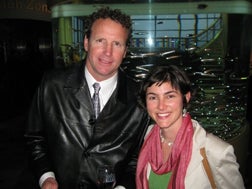 Earlier today, Julie Wormser – EDF Oceans’ regional director in New England, appeared on WBUR’s Radio Boston show to discuss next week’s New England Fishery Council vote on whether or not to transition the region’s groundfish fishery to sector catch shares management. Explaining how catch shares work and answering tough questions from the host and listeners, Julie made the case for how catch shares are an effective way to manage a public resource in a way that rebuilds fish stocks and economically benefits fishermen. Listen to the full show online.
Earlier today, Julie Wormser – EDF Oceans’ regional director in New England, appeared on WBUR’s Radio Boston show to discuss next week’s New England Fishery Council vote on whether or not to transition the region’s groundfish fishery to sector catch shares management. Explaining how catch shares work and answering tough questions from the host and listeners, Julie made the case for how catch shares are an effective way to manage a public resource in a way that rebuilds fish stocks and economically benefits fishermen. Listen to the full show online.
EDFish
The Transition to Catch Shares in New England: EDF’s Julie Wormser on WBUR Radio Boston
Senior Scientist Rod Fujita Comments on NMFS’ New Salmon Biological Opinion
Two weeks ago, the National Marine Fisheries Service release a new Biological Opinion on the ecological challenges of salmon populations in the Pacific, including the California Bay-Delta (Sacramento-San Joaquin). EDF Senior Scientist, Rod Fujita comments on NMFS Biological Opinion and how the efforts of the Bay-Delta Conservation Plan must equally match those of NMFS.
Saving Fishing Jobs and Sea Turtles
 Gulf of Mexico fisheries regulators recently closed down longline fishing (7-9 mile fishing lines with hundreds of hooks) in the Gulf of Mexico off west Florida for six months because the government reported that more threatened sea turtles were being caught than expected. The result of the closure is that turtles will be saved, but jobs will be lost.
Gulf of Mexico fisheries regulators recently closed down longline fishing (7-9 mile fishing lines with hundreds of hooks) in the Gulf of Mexico off west Florida for six months because the government reported that more threatened sea turtles were being caught than expected. The result of the closure is that turtles will be saved, but jobs will be lost.
On top of this six month closure, the Gulf Council will make a decision later this week on additional measures the longline fishermen will have to take to avoid interacting with sea turtles. Again, the good news is that turtles will be saved and the bad news is that jobs will be lost.
 In the midst of all this, our very own Dave McKinney came up with a solution to save turtles and jobs. We’ve started a grant program that provides financial assistance to longline fishermen who convert to vertical gear, which causes far fewer turtle interactions. We have already received almost 30 applications and the new gear has already been put on more than five vessels.
In the midst of all this, our very own Dave McKinney came up with a solution to save turtles and jobs. We’ve started a grant program that provides financial assistance to longline fishermen who convert to vertical gear, which causes far fewer turtle interactions. We have already received almost 30 applications and the new gear has already been put on more than five vessels.
As a result, turtles are safer, fishermen have jobs and we’re thrilled because financially stable fisheries are important for achieving our conservation goals. Florida’s U.S. Senator Bill Nelson and the National Oceanic and Atmospheric Administration have agreed and have given us kudos for finding the ways that work.
Canadian Fishermen Visit New England Counterparts
I love introducing fishermen to each other because they always have lots to talk about. Last week, EDF brought fishermen from British Columbia to six New England fishing communities. More than 100 fishermen from Massachusetts, Maine and Rhode Island attended the meetings, 35 people showed up in New Bedford, MA alone. The BC fishermen also met with 30 fishery managers.
The meetings focused on how catch shares work in B.C. New England fishermen are intensely interested in what’s going on in BC because the fisheries in New England are likely moving to catch shares in the near future. Becky Evans from the New Bedford Standard Times wrote an excellent story on the visits.
EDF has been brining fishermen together for years. We’ve arranged for fishermen to come to BC several times a year because we’ve found that fishermen are the best spokespeople for better fishing management. In fact, EDF brought fishermen from Belize to BC earlier this year.
Eating My Way Toward More Sustainable Oceans
Phoebe Higgins is a loan officer/project manager for the California Fisheries Fund, a project of Environmental Defense Fund.
I consider myself a green foodie, so I was really excited about Monterey Bay Aquarium’s “Cooking for Solutions,” an annual sustainable cuisine event. I got to meet world-famous chefs like Thomas Keller of The French Laundry and learn about sustainable seafood.

Of course the food was out of this world. Who knew that an albacore tuna Reuben could taste so good? A close second was the mosaic fishcake paired with French breakfast radishes from Chez Panisse and a sardine crostini served up by Fish in Sausalito. Although the common thread behind these dishes was their “eco-friendly” status, I was really hoping the menu would share the stories behind the fish.
I’m always curious to know who caught the fish, where, and how the fisheries are being managed. In fact, I think food tastes better when I get to know the people who contributed to bringing it to my plate.
 My project, the California Fisheries Fund, helps make this link. It supports fishermen who bring sustainable seafood to the American table. CFF is a $5 million, first-of-its kind revolving loan fund created to restore California’s fisheries, and we just gave out our first three loans. One of the borrowers, Roger Cullen, is a Morro Bay fisherman whose loan for a new vessel will allow him to fish for black cod and rockfish more efficiently with gear that reduces bycatch.
My project, the California Fisheries Fund, helps make this link. It supports fishermen who bring sustainable seafood to the American table. CFF is a $5 million, first-of-its kind revolving loan fund created to restore California’s fisheries, and we just gave out our first three loans. One of the borrowers, Roger Cullen, is a Morro Bay fisherman whose loan for a new vessel will allow him to fish for black cod and rockfish more efficiently with gear that reduces bycatch.
Roger unloads his catch with another CFF borrower, Morro Bay Fish Company, whose loan proceeds are helping grow its operations for unloading fish from local fishermen who use innovative trap and hook-and-line gear. After reaching the docks, much of this seafood is shipped to Central Coast Seafood, in Atascadero, CA. Their CFF loan has allowed them to upgrade its freezers and inventory and boost marketing for its sustainable products.
 To connect people directly with our borrowers’ products and highlight CFF investments, we held a big launch at Google headquarters in Silicon Valley on March 30th. More than 100 people heard firsthand from the very folks whose livelihood is centered around bringing wild-caught fish to our stores and restaurants. We chose Google as a host because, in contract with Bon Appétit Management Company, they have a strong commitment to purchasing sustainable seafood.
To connect people directly with our borrowers’ products and highlight CFF investments, we held a big launch at Google headquarters in Silicon Valley on March 30th. More than 100 people heard firsthand from the very folks whose livelihood is centered around bringing wild-caught fish to our stores and restaurants. We chose Google as a host because, in contract with Bon Appétit Management Company, they have a strong commitment to purchasing sustainable seafood.
I think the fact that the launch was covered by Fast Company, GreenBiz and Sustainable Industries proves that the business community is starting to take note of the profitability of America’s sustainable fisheries. Best of all, I was able to sit down to a meal of eco-friendly fish and hear the story behind the food I was eating. I’ll never look at smoked black cod toasts and butter-poached sole with cara cara oranges the same way again!
Kemp’s Ridley Sea Turtle Rebound: A Short History
 By Ryan Ono, Gulf Oceans Program Research and Outreach Associate
By Ryan Ono, Gulf Oceans Program Research and Outreach Associate
Until half a century ago, tens of thousands of Kemp’s ridley sea turtles would surge onto Mexican beaches in a few large nesting events to lay their eggs. (One was estimated having up to 40,000 turtles!)
But, at the turn of the 20th century turtle meat and eggs became popular delicacies, causing large numbers of turtles to be harvested at sea and many eggs to be gathered from beaches. Additionally in the 1940s and 1950s, numerous sea turtles were caught in the nets of the rapidly expanding shrimp fishery.
[kml_flashembed movie="http://www.youtube.com/v/mmNdn0hYLZM" width="250" height="207" align="right" wmode="transparent" /] |
These pressures caused the Kemp’s ridley population to crash – almost to the point of extinction, when nesting events would number only one or two thousand turtles.
In the 1960s and 1970s, joint U.S.-Mexican efforts to revive turtle populations re-established a secondary nesting site in the U.S. to protect the eggs from poaching and damage caused by humans. Hatchery and “head-start” programs were also started. The head-start program raised turtles for a few years until they were big enough to be released into the wild – about the size of a dinner plate.
In the 1990s, EDF’s Michael Bean and Pam Baker helped the recovery effort by fighting for gear modifications to all shrimping boats called turtle excluder devices, or “TEDs,” which reduced the number of turtles caught. They also worked for shrimping closures off the Texas coast during nesting seasons.
As recently as eight years ago the number of endangered Kemp’s Ridley turtle nests found on Texas shores numbered fewer than ten. Since 2004 however, there have been consecutive record breaking years and in 2008 a total of 195 Kemp’s Ridley turtle nests were found.
This year’s total stands currently at 154 nests and is on track to surpass last year’s number, with two months of the season left to go. Check back at the end of the summer for an update!









